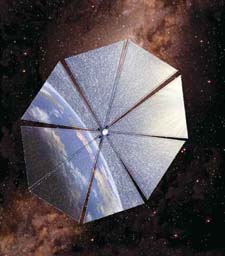 The Planetary Society’s servers were slammed yesterday through the launch and aftermath of the Cosmos 1 mission, but the entries again available on Emily Lakdawalla’s more or less official weblog make for grim reading this morning. For that matter, so does the silence that follows her post at 1915 EDT last night, saying that the search continued for Cosmos 1, but the ground stations that expected to receive the spacecraft’s signal have come up empty.
The Planetary Society’s servers were slammed yesterday through the launch and aftermath of the Cosmos 1 mission, but the entries again available on Emily Lakdawalla’s more or less official weblog make for grim reading this morning. For that matter, so does the silence that follows her post at 1915 EDT last night, saying that the search continued for Cosmos 1, but the ground stations that expected to receive the spacecraft’s signal have come up empty.
True, some signals have been detected, but are they the right ones? Project director Louis Friedman puts it this way: “That the weak signals were recorded at the expected times of spacecraft passes over the ground stations is encouraging, but in no way are they conclusive enough for us to be sure that they came from Cosmos 1 working in orbit.” The Russian space agency indicated that the Volna rocket may have had a problem during its first or second stage firing. “This,” Friedman noted, “would almost certainly have prevented the spacecraft from reaching the correct orbit.”
You can read more of The Planetary Society’s take on its update page. It increasingly appears that Cosmos 1 never made it to orbit because of a failure in the Volna booster, and if that is the case, the outcome is grimly similar to an earlier suborbital test four years ago, when the spacecraft was unable to separate from the booster. The Volna may need some re-engineering when it comes to putting satellites into Earth orbit, although we don’t yet have enough evidence to point to any particular component failure.
While we wait for further news, a few media inaccuracies should be cleared up. For one thing, despite statements in some quarters that no one is investigating the technology of solar sailing but The Planetary Society, the fact remains that both NASA and ESA are actively pursuing solar sail projects. NASA’s work, at various centers including Marshall and Langley, as well as JPL and subcontractors L’Garde and Able Engineering, is advanced, and a variety of missions using the sail as an enabling technology are under consideration.
Secondly, some newspaper stories have reported that a solar sail rides the ‘solar wind.’ It’s an understandable miscue; after all, sails are supposed to be pushed by winds — they certainly are on Earth. A wonderful 1964 story by Arthur C. Clarke was titled “The Wind from the Sun,” creating a public linkage between the solar sail technology that drove the story and the idea of photon pressure as a kind of ‘wind’ that moved through space.
But the actual solar wind is different; it’s a stream of charged particles moving at high speeds (perhaps 500 kilometers per second) from the Sun, one that could be harnessed by some advanced designs like the magnetic sail developed by Robert Winglee and his team at the University of Washington. Even more futuristic magsail designs have been examined by physicists like Dana G. Andrews and Robert Zubrin as candidates for particle beam propulsion, and for deceleration purposes when a high-speed probe enters a destination solar system.
But a conventional solar sail does not rely on the solar wind; it operates because photons, while they have no mass, do have momentum, and they impart that momentum to the sail. Nor is this photon pressure a new discovery. The physics behind it has long been understood, and it has even been tested operationally. In 1974, as Mariner 10 moved toward Venus for a gravity assist that would set it on course for Mercury, the spacecraft’s gyroscopes had malfunctioned and its navigation sensors were confused by flaking paint from its high-gain antenna. A mistaken command sent desperately needed attitude control gas into space.
Getting Mariner re-oriented involved using its big solar arrays, built to absorb sunlight and produce power. Ground controllers knew that if they rotated the arrays to take advantage of the flood of photons pouring out of the Sun, they could stablilize the spacecraft, allowing it to reacquire the star Canopus and thus reestablish celestial guidance on its journey. Mariner 10 wasn’t meant to be a solar sail experiment, but in certain respects it turned into one, at least insofar as it demonstrated the principle. A pity that Cosmos 1 wasn’t able to make its own contribution, but the solar sail idea, which has a long history, is surely destined to have an even brighter future.
Image credit (above): Rick Sternback/The Planetary Society (c).


I just wish one of these would succeed. A source of energy for travel such as this should be actively pursued by NASA and the international community, not left to off-projects with low sucess rates. The failure of the NanoSail-D is another example of this phenomenon. Wouldnt it be awesome if this worked and humans could accelerate their space vehicles without needing fuel. Why does no one else think this as an apex issue? Free fuel and potential sustainable speeds for space vehicles that we haven’t seen before. If this succeeds once it will take off. Until that day I will have to wait and see.